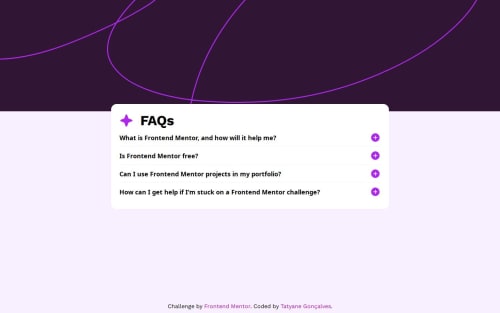
Solution retrospective
Olá, pessoal! 😄👋
Aqui está mais uma solução de desafio feito por mim.
As tecnologias utilizadas foram: 👩💻
- HTML
- CSS
- SASS
- JS
Estou aberta a receber dicas e feedbacks. Obrigada!!
Please log in to post a comment
Log in with GitHubCommunity feedback
- @petritnuredini
Congratulations on completing the FAQ Accordion project! Your implementation showcases good HTML structure, CSS styling, and JavaScript functionality. Here are some best practices to enhance your project further:
-
Semantic HTML: Great use of semantic elements like
<main>,<section>, and<picture>. Consider using<details>and<summary>tags for a more semantic accordion structure. Learn about semantic HTML here. -
CSS Best Practices: Your CSS is well-organized. As your projects grow, consider adopting a naming convention like BEM for better readability and maintainability. Learn about BEM here.
-
Responsive Design: Ensure that the design is fully responsive and looks good on all devices. Use media queries to adjust layout and font sizes for different screen sizes. More on responsive design here.
-
Accessibility: Focus on making your website accessible, including keyboard navigation and proper ARIA roles for interactive elements. More about web accessibility can be explored here.
-
JavaScript Best Practices: Keep your JavaScript code clean and well-commented. Avoid using the same
idfor multiple elements asidshould be unique. Consider usingclassinstead. More on JavaScript best practices here. -
Performance Optimization: Optimize images for faster loading times and better performance. More on image optimization here.
Keep up the great work! Your dedication to crafting well-structured and interactive web pages is commendable. Continue exploring and experimenting with new techniques and technologies in your web development journey!
Marked as helpful -
Join our Discord community
Join thousands of Frontend Mentor community members taking the challenges, sharing resources, helping each other, and chatting about all things front-end!
Join our Discord